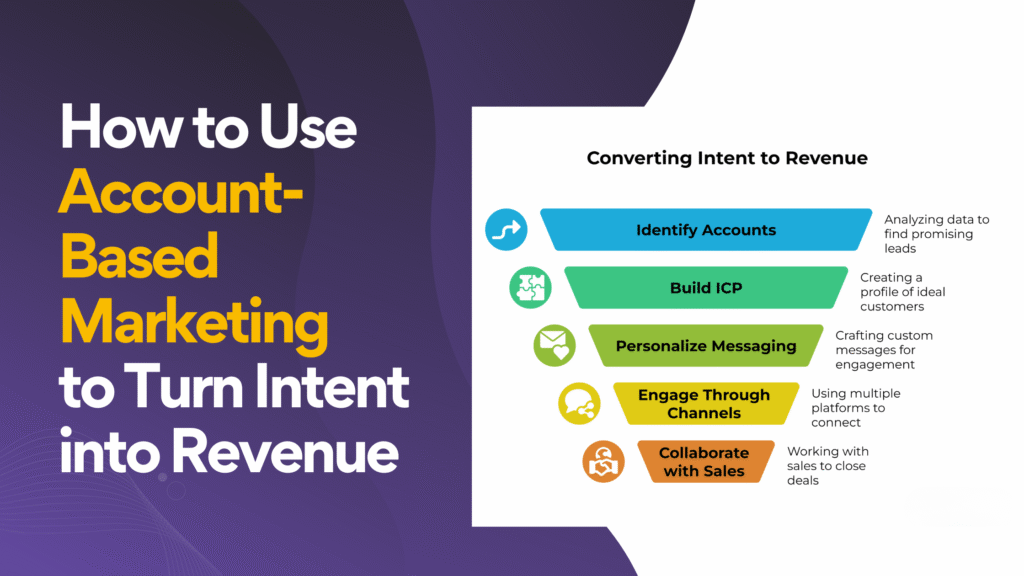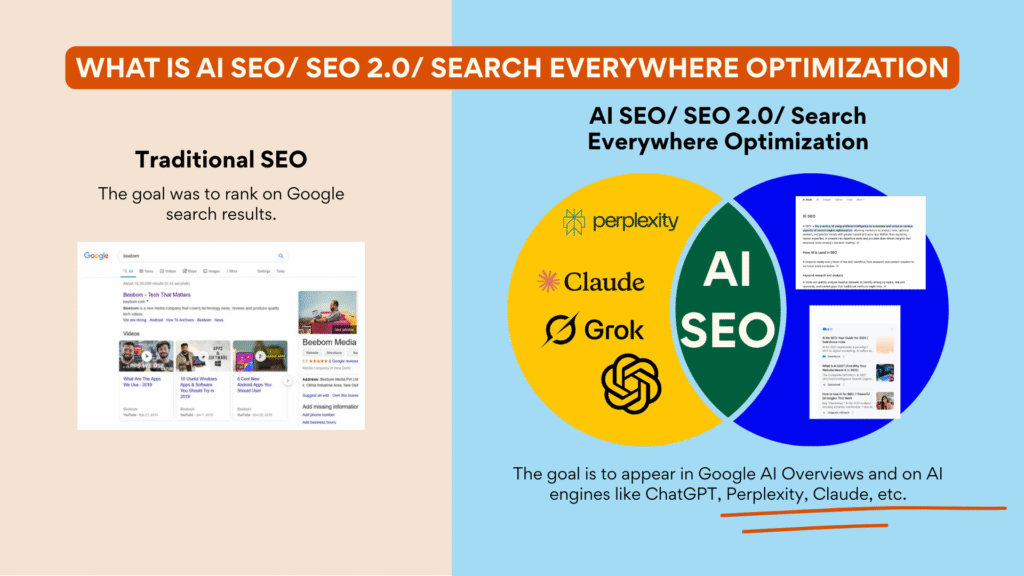In today’s evolving marketing landscape, traditional lead generation strategies are no longer enough. Yes, you can have a number of leads, but if they aren’t matching the right intent or bringing you the desired conversion rate, they aren’t really adding any value.
This is where Account-Based Marketing has become a crucial marketing approach. Account-Based Marketing is no longer a buzzword. This technique is now a crucial strategic framework that allows you to focus on the genuine target audience, yield leads that actually match the intent, and bring you the desired conversions.
Why Traditional Marketing Won’t Work for Your High-Ticket Clients?
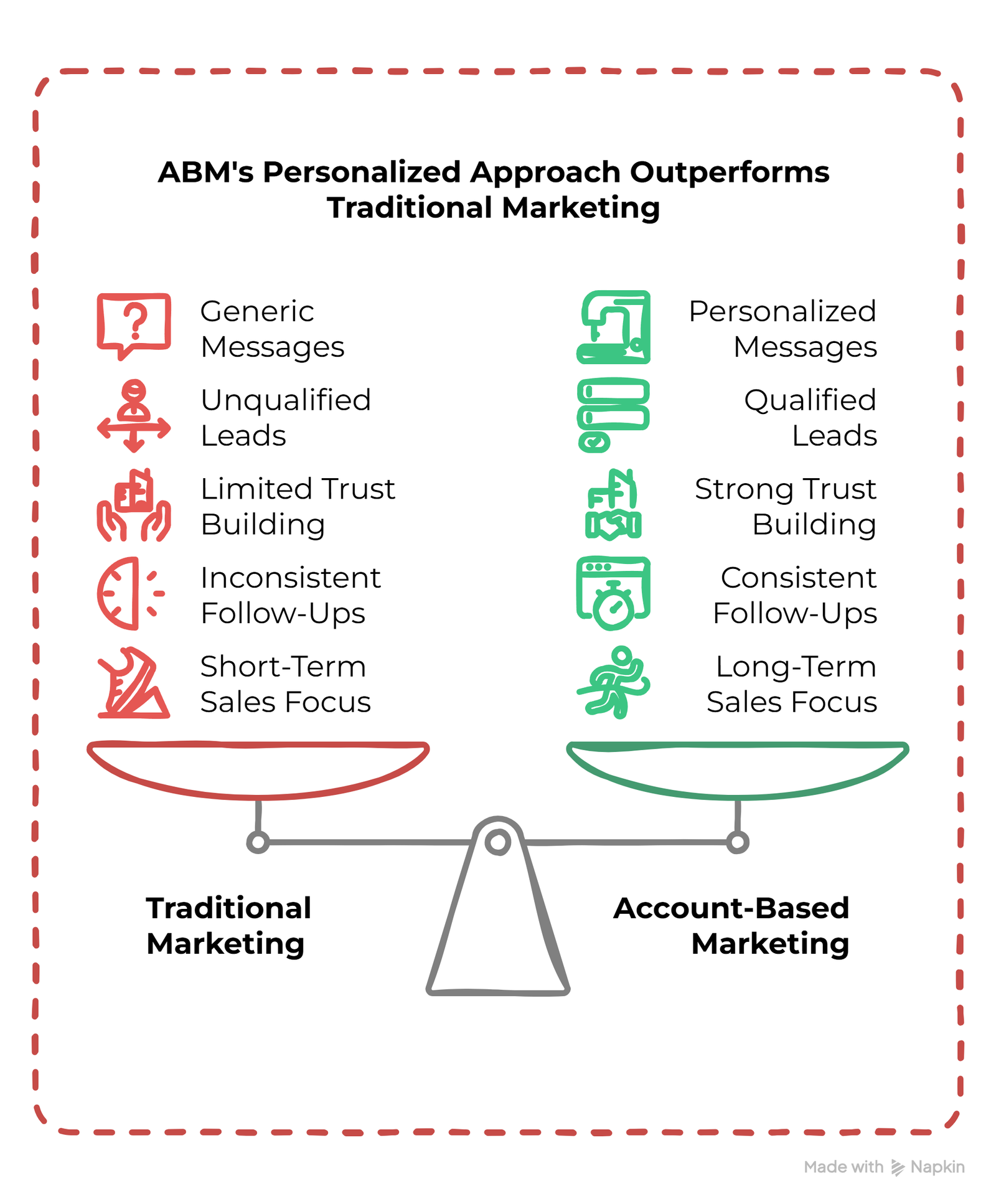
Before we start with Account-Based Marketing, let’s understand what the flaws are with traditional marketing when you are focusing on a high-ticket client. Traditional marketing like marketing with pamphlets, hoardings, marketers in the field, usually follow a spray-and-pray approach. This might work for a broader audience, but the results aren’t often as desired with high-ticket clients.
Generic Messages Don’t Work Here!
Imagine you see a pamphlet. For how long are you able to retain the pamphlet ad? Maybe for a few minutes, or at best, a few hours. Messages via pamphlets or hoardings are largely generic, and high-ticket clients demand being specific to their needs and challenges.
Quality is Often Compromised
When you focus on traditional marketing, you target a broad set of audience without being specific. You don’t have a set group, which often leads your marketing to be wayward and ineffective. Traditional marketing often leads you to unqualified or irrelevant leads that waste your time & resources.
Trust Building Demands a Different Approach!
Closing a high-ticket client demands way more than a generic, simple pitch. It demands building relationships, highlighting the ways in which you are solving clients’ pain points, and being specific. The marketing with pamphlets or hoardings doesn’t meet these requirements, and hence, trust isn’t created. ABM’s digital funnel gives you a platform where you can showcase & establish your authenticity, expertise, relevance, and build trust for a long-term relationship.
Inconsistent Follow-Ups Often Bring Missed Opportunities
A traditional marketing funnel won’t allow you to follow up consistently with the client. The importance of consistent follow-up after you pitch a high-ticket client cannot be stressed enough. Once that billboard is fixed or the pamphlet is handed over, what are the chances that you will follow up? Very few. And, it clearly implies a missed opportunity.
The Focus
Traditional marketing primarily focuses on short-term & broad-based sales, and the conversion rate is relatively low. This implies that the desired results, specifically with regard to high-ticket client conversion are difficult to achieve with traditional marketing.
What is Account-Based Marketing(ABM)?
Now, when you know why you cannot trust traditional marketing while targeting high-ticket clients, let’s know things about ABM. Let’s not make it complex. ABM is just a marketing effort where you focus on a specific set of target accounts rather than following a broad approach. You basically target the accounts that have higher chances of conversions.
With Account-Based marketing, you consider a single account as an entire market. You personalize your marketing campaigns according to that single account to meet the requirements of that account.
Core Principles of ABM
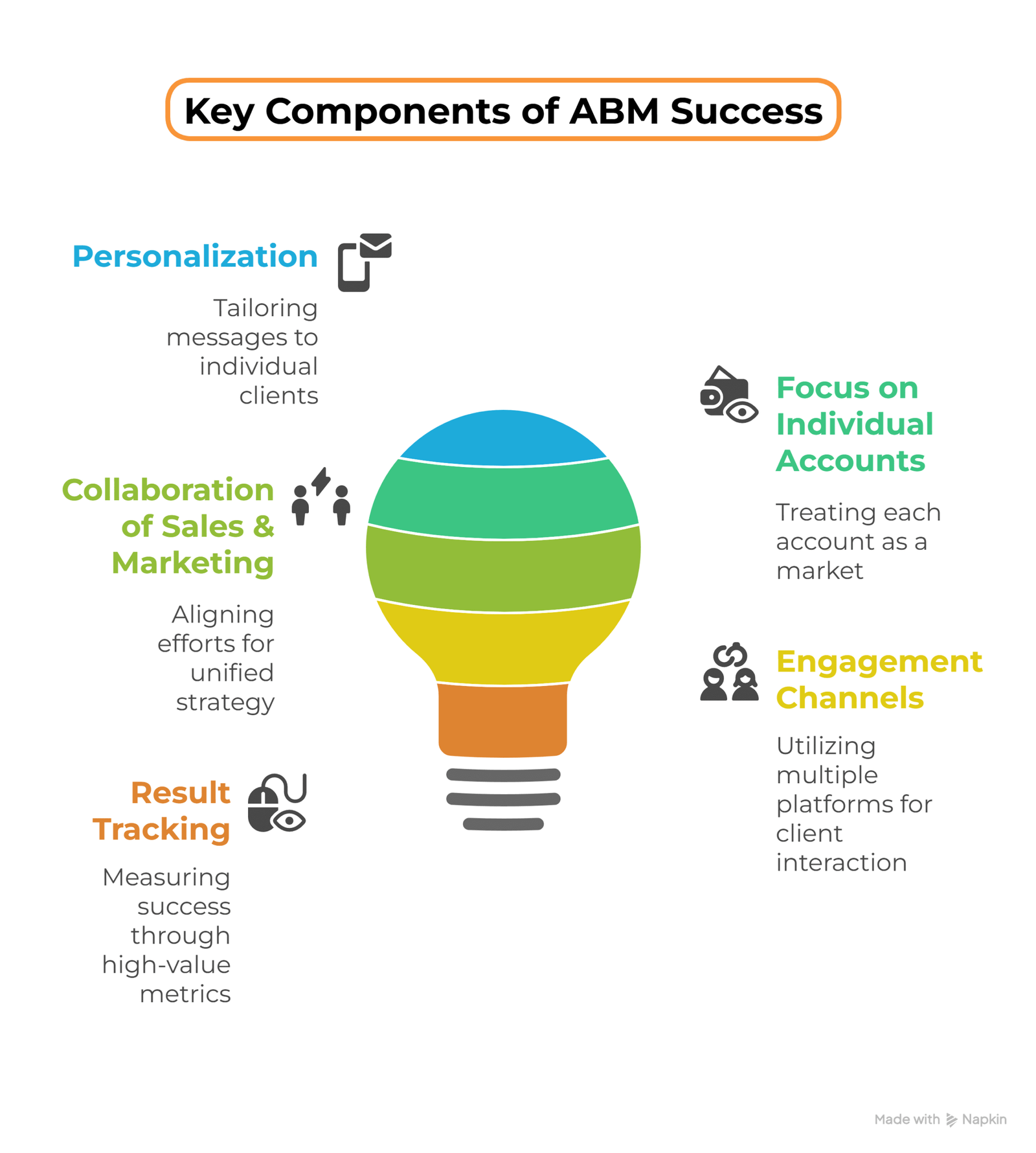
The core principles that play a crucial role in defining the success of ABM are as follows.
Personalization
The personalized messages, emails, and follow-ups play a crucial role in any ABM strategy. It implies that you would be creating personalized emails, offers, and overall content that you use to pitch the client.
Do consider the industry trends, the client’s mindset, the recent activity of the client, and your overall vision with the solution you are providing while creating your pitch.
Focus on Individual Accounts
ABM treats every account as a market. Hence, unlike traditional marketing, you don’t focus on the entire industry or a large chunk of the audience. With ABM, you primarily focus on an individual account with your strategy focused on the account’s requirements, vision and goals.
Collaboration of Sales & Marketing
A good ABM strategy demands a strong collaboration between sales & marketing. Some aspects on which both departments should agree are:
- Content pitch
- Target individual accounts
- Follow-ups
- Marketing funnel from first pitch to closed deal
Engagement Channels
High-ticket clients don’t usually convert by just one channel. You should be considering multiple channels. The major channels to focus on are:
- Media
- Paid Ads
- Events
No matter what channels you select, be sure to be consistent and relevant through all channels.
Result Tracking
ABM by no means tracks results and success on the basis of clicks or website traffic. The results with this strategy are tracked by:
- Win rates
- Number of deals done
- The size of deals done
- Account engagement rate
- Leads achieved from high-ticket clients
Basically, ABM focuses more on the numbers yielded from high-ticket clients.
ABM vs Traditional Lead Generation
Let’s understand the basic and important differences between ABM & Traditional Lead Generation strategies with a table.
| Aspect | ABM | Traditional Lead Generation |
| Approach | Focuses on individual accounts | Focuses on a broader market or industry |
| Goal | To convert high-ticket clients | To generate a larger number of leads |
| Target Audience | Specific companies or relevant individuals | A huge number of individuals |
| Pitch | Personalized | Generic |
| Engagement Channels | LinkedIn, Emails, Instagram, and many more | Pamphlets, Hoardings, Advertisements, Human Marketer on field |
| Conversions | High | Comparatively low |
| Best Suited For | High-ticket clients & complex sales cycle | Low-ticket or mostly transactional sales |
Step-By-Step Process to Use ABM & Convert Intent Into Revenue
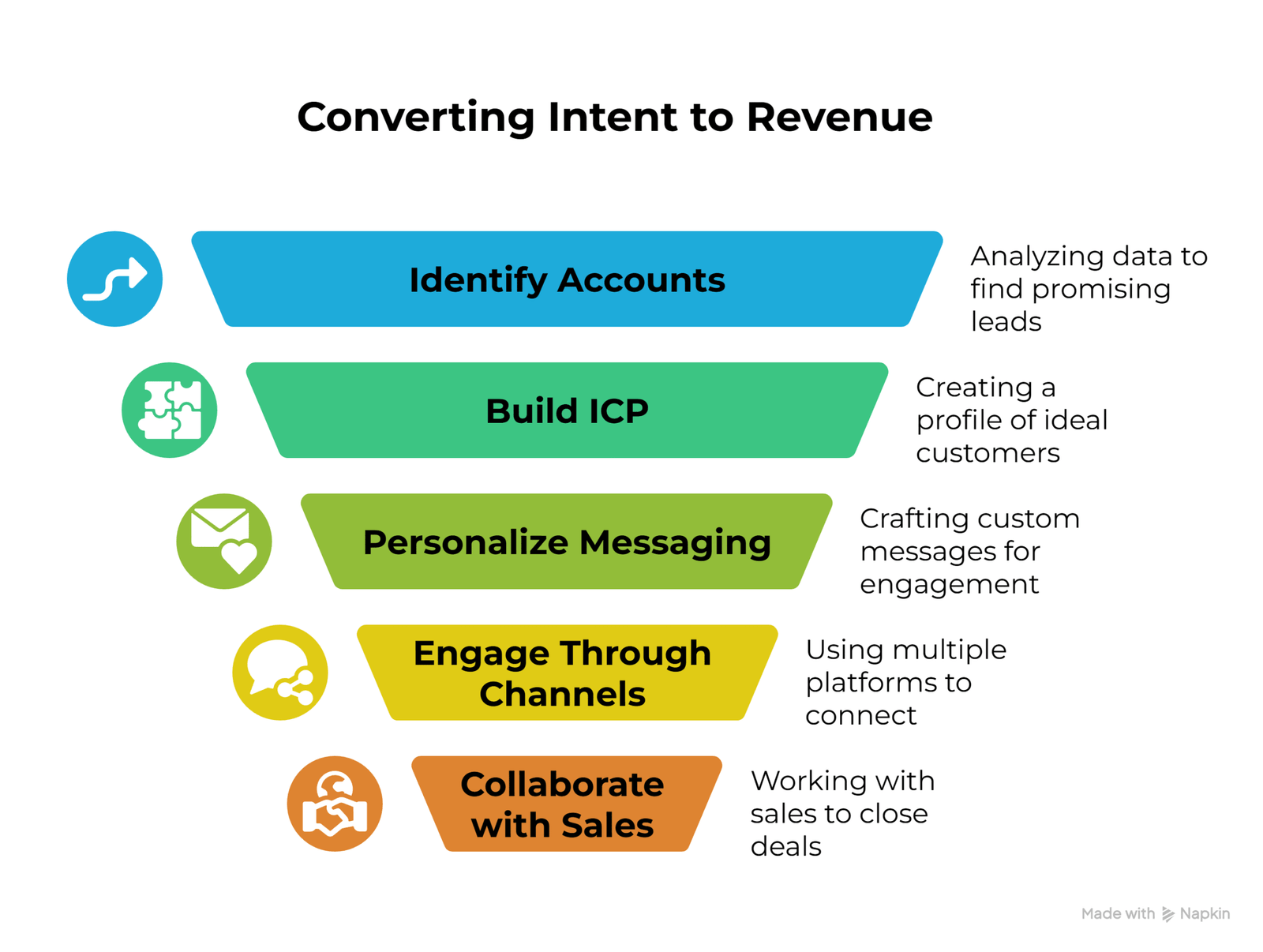
Turning an intent into revenue isn’t a one-night thing. You need a systematic approach, a solid ABM strategy, and a highly personalized way to yield the desired results. Let’s check out a step-by-step guide you can follow to convert the intent into revenue.
Identify Right High-Intent Accounts
The first step of a solid ABM strategy is to identify the correct high-intent accounts. Remember, not every account that sounds high-ticket might be your answer.
You can use the following aspects to identify the right high-intent accounts:
- Data like website visits, demo requests, etc.
- Visits to the price or specific product pages
- Case studies or webinar engagement
- Search behaviour, specifically, around your domain
Build an Ideal Customer Profile (ICP)
Building an ICP is essential to know that:
- You are targeting the accounts that have the budget & feasibility to buy your solutions.
- Your solutions align with the requirements & vision of the target accounts.
- Your solution fits the industry niche accurately.
To build an ICP, you can use tools like Powerleads, Deep Enrich, etc. These tools can give you a fair idea of aspects like industry, decision-makers’ information, pain points of the company, etc.
Work on Personalization!
Once you are done building an ICP and figuring out your target audience, you need to start working on the personalization.
Here, you build the custom messages to resonate with the target accounts. The personalization also includes:
- Customized landing pages
- Ad copies
- Emails, LinkedIn pitches, and follow-up messages
- Case studies
Be a bit creative and crisp here. Maintain relevance throughout and with each piece of content by highlighting how you are solving the client’s problem. Do it subtly and try not to sound too desperate or forceful.
Use Multiple Channels to Engage
High-ticket clients would demand some time and effort to convert. Hence, you need to keep on engaging with them via multiple channels.
Some useful channels & tactics to do so include:
- Email chains
- Webinars, ebooks, and gated content
- Ads & Engagement campaigns
You need to use these channels to build trust, educate, and build a connection with the client.
Collaboration with Sales Team
If you feel the target is showing interest in your services, collaborate with the sales team to follow up.
Use the follow-up content you have used wisely, add the inputs from the sales team and get the team to interact with the client and follow up. Regular follow-ups won’t only boost the chances of conversions, but also help you figure out if you are on the right track with solving the pain point of the target.
Important Tools to Form an Efficient Account-Based Marketing Strategy
An effective ABM strategy is divided into various stages. Let us go through the various tools that you can use at every stage to implement your ABM strategy effectively.
To Build ICP
In this stage, you mainly focus on building segmented lists and gathering information about the decision-makers of the company. Some crucial tools that can be effective are Apollo, ZoomInfo, and ContactOut.
Outreach
Here, you try to contact leads by using personalized LinkedIn messages and starting an email chain. The tools that can help make your job easier are Waalaxy, Lemlist.
Engagement
In this stage, you try to increase your engagement rate with your target client. You use a content-based engagement approach here. LinkedIn can be your crucial tool here.
Nurture
An email drip campaign is used to build trust among high-ticket clients. Basically, you try to strengthen the relationship and build trust. Some important tools to consider are Mailmodo, HubSpot.
Analytics
The last and one of the most crucial steps is Analytics, where you track the results of your strategy, recognize the loopholes, and fix them. The tools that can help you with result tracking are GA4, HubSpot CRM, etc.
Important Metrics to Measure ABM Success
Let’s check out the key performance indicators that can help you evaluate the success of your ABM efforts.
Account Engagement Rate
This metric primarily measures how many interactions your target accounts have with your brand channels.
Some crucial aspects that this metric tracks are:
- Page views by the target accounts
- Ad impressions
- Content engagement
- LinkedIn engagement
- CTRs
The higher the engagement rate is, the higher the chances are of conversions.
Pipeline Velocity
This metric measures the speed at which the accounts are moving throughout the sales funnel.
Some crucial aspects tracked here are:
- Timeframe from first interaction to opportunity creation
- Timeframe from opportunity creation to deal closure
- Timeframe from deal closure to solution purchase
Deal Size & Close Rate
How many big deals is your ABM effort closing? You need to analyze this aspect to figure out if you are on the right path.
The important aspects measured here are:
- Comparison of the deal size with ABM and non-ABM leads
- The conversion rate
- Stakeholder engagement in large deals
Customer Acquisition Cost
Here, you figure out if ABM is actually more effective than traditional marketing and is worth it. Some aspects to track are:
- Total spendings
- Total profit from the closed deals
- Customer lifetime value ratio
Final Thoughts: Why Do You Need ABM Now?
Today, customer behaviour has changed drastically. The customer is more informed, hard to reach, and most importantly, hard to convert. If you are solely focusing on traditional marketing or generic marketing, you are doing a lot of things wrong.
ABM is no longer just a trend. It is a basic and one of the most crucial elements of any marketing strategy. A strong ABM strategy can help you with:
- Engage with high-ticket clients at the right time
- To drive valuable engagements and conversions
- To shorten the sales cycle
- To close huge deals
- To build long-term relationships with high-ticket clients
Ready to Turn Intent Into Revenue?
If you are already working on traditional marketing and looking to plan and execute an ABM strategy, we can help you build an ABM engine that not only drives your growth but also sustains it.
Our experienced team can help you form a solid ABM strategy and can help you execute the same with perfection. Book your appointment with the expert team of SEO Inventiv now, and let’s close those huge deals together!
 WhatsApp Now
WhatsApp Now
 +(91) 8700778618
+(91) 8700778618


